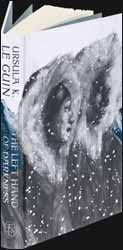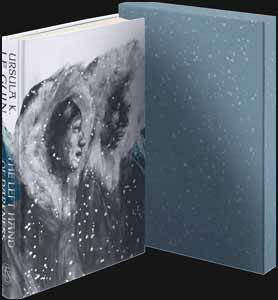|
Click here to return to the main site. Book Review
When Genly Ai is sent to the planet of Gethen he finds that, surprisingly, the population has no fixed gender. Coming from a society where gender is fixed creates difficulty and misunderstanding in his interactions with the planet's population. Sent from Terra to invite the Gethen’s to join the coalition of human worlds, the Ekumen, Genly’s struggles are mirrored by the Gethen’s mild revulsion at his perverse single sex state. When his close Gethen, Estraven, is deemed a traitor, Genly is forced on the run. Over his travels he learns more about the planet and Estraven and Genly come to a greater understanding of each other… The Left Hand of Darkness (2018 Folio Edition. 288 Pages. 9½˝ x 6¼˝) is a science fiction novel by Ursula K. Le Guin. The book won both the Hugo and Nebula awards and is part of her Hainish Cycle of novels. Not only is this the best known of Guin’s works, it is without doubt one of the top five science fiction novels published to date. The themes of sexual fluidity remain just as pertinent today as when the book was first published in 1969, just in time for the glam rock movement in music which itself played with ideas of gender roles. The coalescing themes, between the book and the wider cultural experimentation, made the book extremely contemporarily relevant. Not that female science fiction writers had either ignored a feminist perspective or used the genre to examine sexual identities, arguably Virginia Wolf’s novel, Orlando, published in 1928 had covered similar ground. Where Guin progressed this idea, from a binary perspective, was to take a culture which for much of its time is neither male nor female. The inhabitants of Gethen spend most of their time in a neutral state only settling into one of two binary states, male or female, for the purposes of reproduction. This simple change in sexuality causes difficulty for Genly. Although not explicitly mentioned the Terran culture must still be one built, if only partially, around gender difference and roles. The Gethen’s ambisexuality creates a cultural chasm of misunderstanding which he must overcome, if there is to be any understanding between the Gethen and the rest of the human worlds. There is much in the novel which goes to the heart of gender roles, but Guin does not sacrifice strong narrative for a polemical attack on a single sex. She did run into some criticism for mostly using male pronouns when describing the Gethen’s, but I feel this was unfair as the book is written from Genly’s perspective who, as a male, is looking for a point of contact between his singular status and their non-duality. At the beginning of the book he tries to ascribe certain traits to the people he interacts with. If they have soft features he presumes that they are the ones who will choose to become female for mating purposes, without having the personal insight into understanding that he is trying to impose his idea of gender roles on a species which have none. It is only under duress do Estravan and he comes to some level of understanding of how sexuality has defined their respective cultures. As ever Folio presents the book in a beautiful edition. There is a poignant introduction by Becky Chambers, Guin died just after the introduction was complete and Chambers has been allowed an addendum to her original piece. The blue/grey slipcase has a snow motif, reflecting Gethen's eternal coldness. The book is heavily illustrated by David Lupton, who has chosen to portray the Gethen’s as a combination of eskimo and native American. You get fourteen black and white illustrations which have been integrated into the text as well as a double page spread within the body of the text and adorning the inside of the front and back cover. Once again, Folio has offered up a loving presentation of a science fiction classic. 10 Charles Packer
|
|---|

